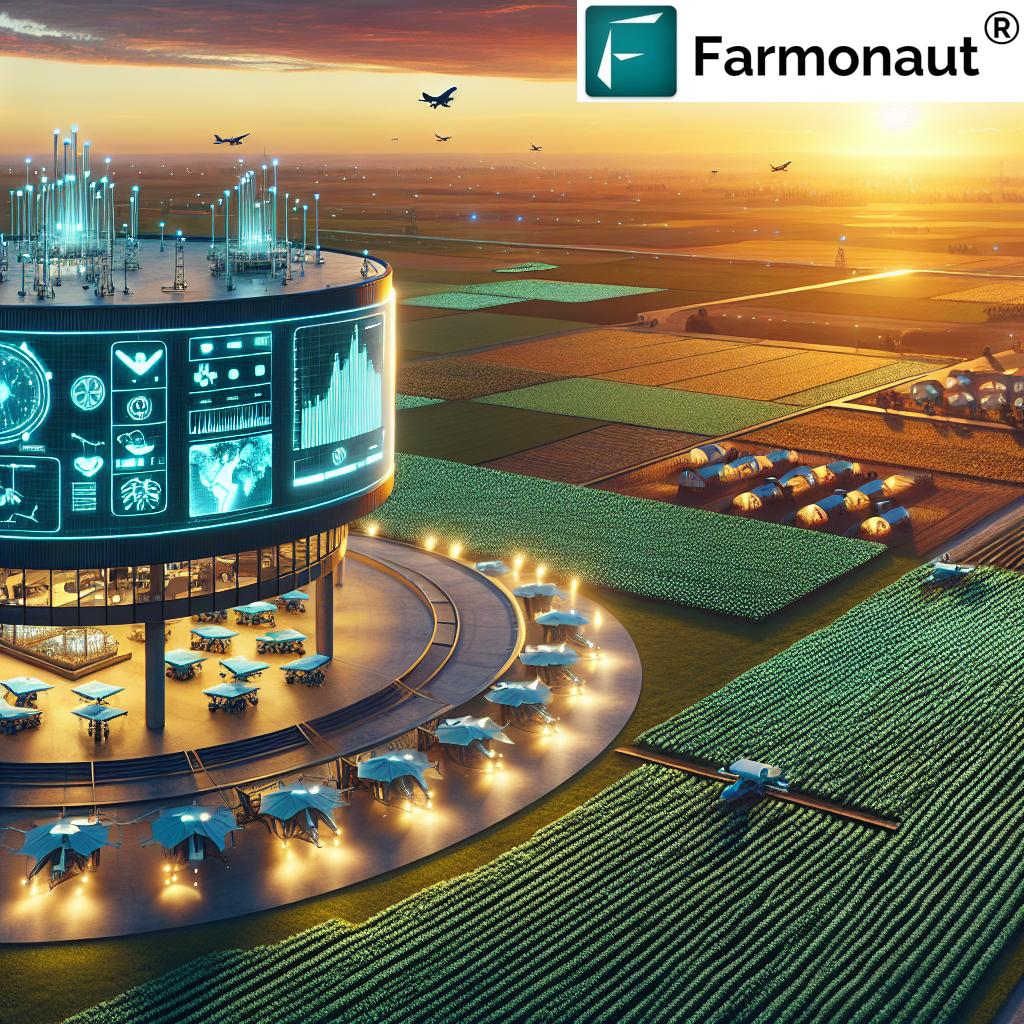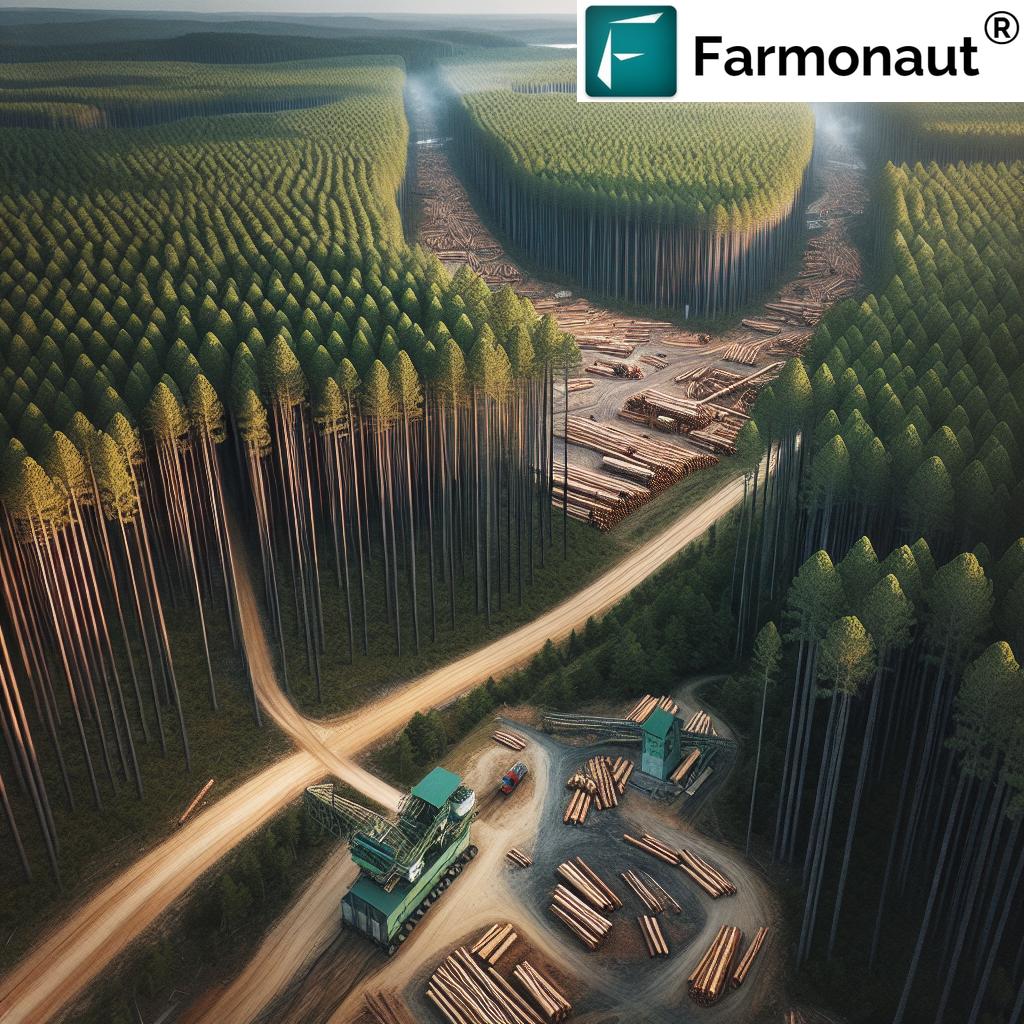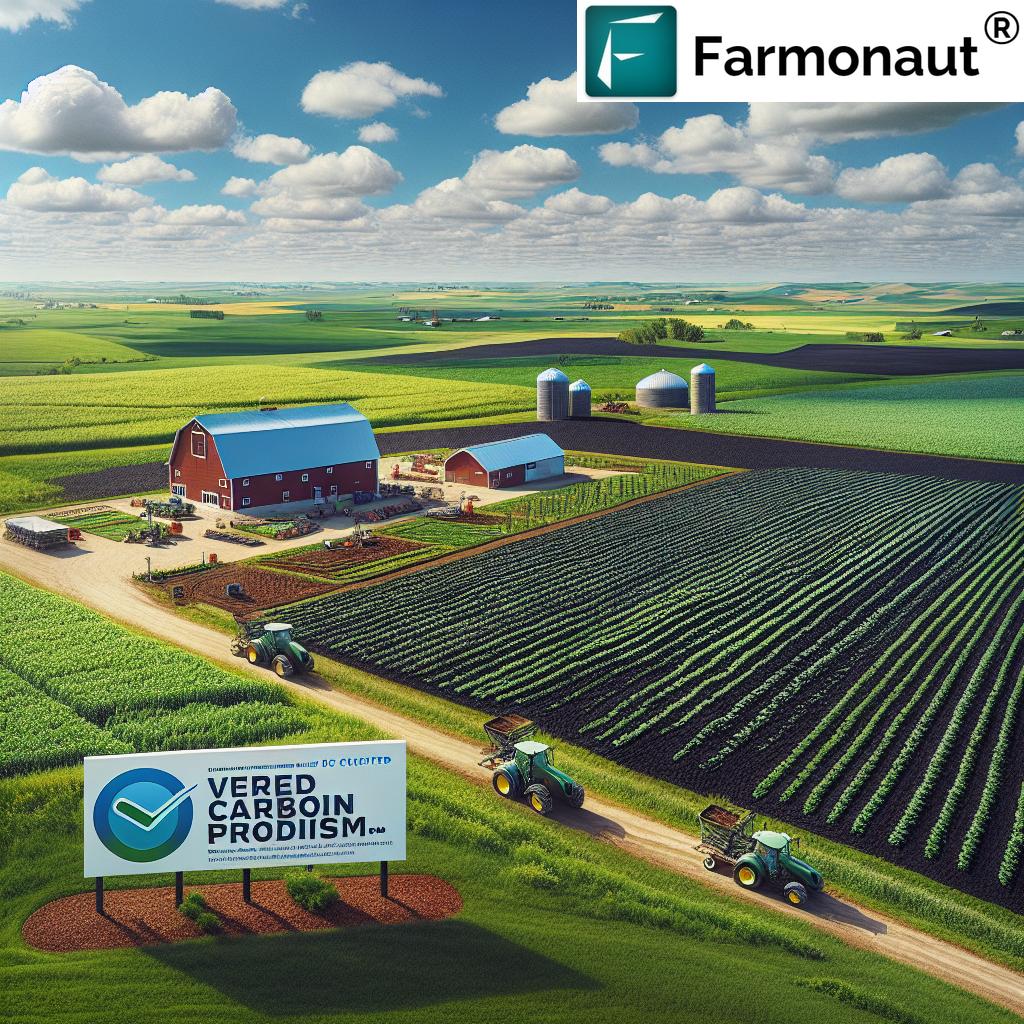Revolutionizing Agriculture: How Autonomous Drones Are Transforming Crop Protection in the United States

“Autonomous agricultural drones can operate in low-light conditions, extending farming activities into nighttime hours.”
In recent years, we’ve witnessed a remarkable transformation in the agricultural landscape of the United States. The integration of autonomous drones and unmanned aircraft systems has ushered in a new era of precision agriculture technology, revolutionizing the way we approach crop protection and farm management. At Farmonaut, we’re at the forefront of this agricultural revolution, providing innovative satellite-based solutions that complement these groundbreaking advancements in drone technology.
As we delve into the world of autonomous agricultural drones and their impact on crop protection, it’s crucial to understand the broader context of smart farming solutions and how they’re reshaping the future of agriculture in the United States.
The Rise of Autonomous Drones in Agriculture
The agricultural sector has long been searching for ways to improve efficiency, reduce costs, and minimize environmental impact. Autonomous drones have emerged as a game-changing solution, offering unprecedented precision and capabilities in crop management and protection. These unmanned aircraft systems are equipped with advanced sensors, cameras, and AI-powered algorithms that enable them to perform a wide range of tasks with minimal human intervention.
Some key applications of autonomous drones in agriculture include:
- Precision crop spraying
- Soil and field analysis
- Crop health monitoring
- Irrigation management
- Yield prediction
One of the most significant advancements in this field has been the development of unmanned crop dusting systems. These large-scale drone farming solutions are addressing long-standing challenges in agricultural aviation, particularly in terms of safety and efficiency.
Unmanned Crop Dusting: A Safety Revolution
Traditional crop dusting methods have long been associated with significant risks to pilots and the environment. The introduction of autonomous helicopter spraying systems marks a pivotal moment in agricultural aviation safety. These unmanned aircraft are designed to cover expansive areas that smaller drones simply can’t manage due to size and power limitations.
Companies like Rotor Technologies, founded by former helicopter pilot Hector Xu, are at the forefront of this innovation. Their flagship product, the Sprayhawk, is a modified Robinson R44 helicopter equipped with cutting-edge technology for autonomous operation. This includes:
- Multiple cameras
- Laser sensors
- Radar systems
- GPS navigation
- Advanced motion sensors
These features enable the Sprayhawk to navigate complex terrains and operate efficiently, even during night flights. The emphasis on safety is paramount, with built-in contingencies like controlled landing protocols in case of communication loss.
Explore Farmonaut’s satellite-based crop monitoring solutions: 
Night Vision Agriculture Drones: Extending Operational Hours
One of the most exciting developments in autonomous drone technology is the integration of night vision capabilities. These advanced systems allow for 24/7 operation, significantly extending the window for critical agricultural tasks like crop spraying and monitoring.
Night vision agriculture drones offer several advantages:
- Reduced interference with daytime farm operations
- Cooler night temperatures for optimal spraying conditions
- Less wind interference during nighttime hours
- Extended operational time for large-scale farms
By leveraging these night vision technologies, farmers can maximize productivity and efficiency, ensuring that crop protection measures are implemented around the clock.
Precision Agriculture Technology: A Data-Driven Approach
The integration of autonomous drones with precision agriculture technology is creating a powerful synergy in farm management. These systems collect vast amounts of data that can be analyzed to make informed decisions about crop health, resource allocation, and pest management.
At Farmonaut, we complement these drone-based solutions with our satellite-based crop health monitoring services. Our platform provides farmers with real-time insights into vegetation health, soil moisture levels, and other critical metrics. This data-driven approach enables farmers to:
- Optimize irrigation strategies
- Fine-tune fertilizer application
- Detect and address pest infestations early
- Predict and maximize crop yields
Harness the power of satellite-based farm management with Farmonaut’s Android app: 
Overcoming Challenges: Agricultural Drone Regulations
As with any emerging technology, the integration of autonomous drones into agriculture faces regulatory challenges. In the United States, the Federal Aviation Administration (FAA) plays a crucial role in overseeing the use of unmanned aircraft systems in commercial operations, including agriculture.
Key regulatory considerations include:
- Pilot certification requirements
- Airspace restrictions
- Night flight permissions
- Safety protocols for autonomous systems
Companies like Rotor Technologies are working closely with regulatory bodies to ensure their autonomous helicopters meet all necessary safety and operational standards. As the technology continues to evolve, we can expect to see more tailored regulations that balance innovation with safety concerns.
“Large-scale drone farming systems can cover expansive areas that exceed the capabilities of traditional smaller drones.”
The Future of Crop Protection: Automation and AI
The future of crop protection lies in the seamless integration of autonomous drones, artificial intelligence, and advanced sensing technologies. These smart farming solutions are not just about replacing human labor; they’re about enhancing decision-making processes and optimizing resource utilization.
Some of the exciting developments on the horizon include:
- AI-powered pest identification and targeted treatment
- Predictive modeling for disease outbreaks
- Automated crop health diagnostics
- Real-time yield forecasting
At Farmonaut, we’re contributing to this future with our AI-driven Jeevn advisory system, which provides personalized farm management insights based on satellite data and advanced analytics.
The Economic Impact of Autonomous Drones in Agriculture
The adoption of autonomous drones and unmanned crop dusting systems is not just a technological advancement; it’s an economic game-changer for the agricultural sector. By improving efficiency and reducing labor costs, these technologies have the potential to significantly boost farm productivity and profitability.
Key economic benefits include:
- Reduced operational costs for crop protection
- Increased crop yields through precision application of inputs
- Minimized crop damage from over-spraying or misapplication
- Extended operational hours, leading to faster response times for pest and disease control
As these technologies become more widespread, we can expect to see a shift in the agricultural labor market, with a growing demand for skilled technicians and data analysts to manage and interpret the vast amounts of information generated by these autonomous systems.
Access Farmonaut’s powerful API for integrating satellite and weather data into your agricultural systems: Farmonaut API
Environmental Benefits of Precision Drone Technology
One of the most compelling aspects of autonomous agricultural drones is their potential to significantly reduce the environmental impact of farming practices. By enabling precise application of pesticides and fertilizers, these systems can help minimize chemical runoff and reduce overall usage of potentially harmful substances.
Environmental advantages include:
- Reduced water consumption through targeted irrigation
- Minimized soil compaction due to fewer tractor passes
- Decreased chemical usage through spot-treatment of pests and diseases
- Lower carbon emissions compared to traditional crop dusting aircraft
These benefits align closely with Farmonaut’s mission to promote sustainable farming practices. Our carbon footprinting feature, for instance, helps agribusinesses monitor and reduce their environmental impact, complementing the eco-friendly advantages of autonomous drone technologies.
Integrating Autonomous Drones with Existing Farm Management Systems
For autonomous drones to reach their full potential in agriculture, they must be seamlessly integrated with existing farm management systems. This integration allows for a holistic approach to precision agriculture, where data from multiple sources can be combined to provide comprehensive insights and actionable recommendations.
Key integration points include:
- Synchronization with weather data and forecasts
- Connection to soil sensors and irrigation systems
- Integration with farm management software for task planning and resource allocation
- Compatibility with satellite-based monitoring systems like Farmonaut’s platform
By creating a unified ecosystem of smart farming solutions, farmers can make more informed decisions and optimize their operations across all aspects of crop production and protection.
Explore Farmonaut’s iOS app for on-the-go farm management: 
Training and Education for the Autonomous Agriculture Era
As autonomous drones become more prevalent in agriculture, there’s a growing need for specialized training and education programs. Farmers, agronomists, and agricultural technicians must develop new skills to effectively operate, maintain, and interpret data from these advanced systems.
Essential training areas include:
- Drone piloting and autonomous system management
- Data analysis and interpretation
- Precision agriculture techniques
- Regulatory compliance and safety protocols
Universities and agricultural colleges across the United States are beginning to offer courses and degree programs focused on these emerging technologies. Additionally, companies like Farmonaut provide resources and support to help farmers make the most of satellite-based and drone-enabled precision agriculture tools.
The Global Perspective: Autonomous Drones Beyond the United States
While our focus has been on the United States, it’s important to note that the adoption of autonomous drones in agriculture is a global phenomenon. Countries around the world are exploring and implementing these technologies to address their unique agricultural challenges.
Some international developments include:
- Brazil’s rapid adoption of drone technology for large-scale crop monitoring and spraying
- Japan’s use of drones for precision rice farming in small, irregularly shaped fields
- Australia’s implementation of long-range drones for cattle monitoring on vast ranches
- India’s exploration of drone swarms for coordinated crop protection in smallholder farms
As a global company, Farmonaut is well-positioned to support the integration of satellite-based monitoring with drone technologies across diverse agricultural landscapes worldwide.
Comparison of Autonomous Drone Technologies for Crop Protection
| Technology Type | Key Features | Operational Capabilities | Potential Benefits |
|---|---|---|---|
| Unmanned Crop Dusting Drones |
|
|
|
| Autonomous Helicopter Spraying Systems |
|
|
|
| Night Vision Agriculture Drones |
|
|
|
The Role of Satellite Technology in Complementing Drone Operations
While autonomous drones are revolutionizing on-the-ground crop protection, satellite technology plays a crucial role in providing a broader perspective of agricultural operations. At Farmonaut, we specialize in satellite-based farm management solutions that complement and enhance the capabilities of drone technologies.
Key benefits of integrating satellite data with drone operations include:
- Comprehensive field monitoring over large areas
- Historical data analysis for long-term trends
- Cloud penetration capabilities for consistent monitoring
- Cost-effective solution for frequent, large-scale observations
By combining the high-resolution, targeted data from drones with the broad, consistent coverage of satellites, farmers can achieve a more complete understanding of their crops and make more informed decisions about resource allocation and crop protection strategies.
The Future of Farming: Embracing Technological Innovation
As we look to the future of agriculture in the United States and beyond, it’s clear that technological innovation will play a pivotal role in addressing the challenges of food security, environmental sustainability, and economic viability. Autonomous drones, precision agriculture technology, and smart farming solutions are at the forefront of this agricultural revolution.
Key trends to watch include:
- Integration of AI and machine learning for predictive crop management
- Development of swarm technologies for coordinated drone operations
- Advancements in battery technology for extended drone flight times
- Improved data analytics platforms for actionable farm insights
At Farmonaut, we’re committed to staying at the cutting edge of these developments, continually enhancing our satellite-based solutions to provide farmers with the most comprehensive and valuable agricultural intelligence possible.
Conclusion: A New Era of Crop Protection
The integration of autonomous drones into agricultural practices marks a significant milestone in the evolution of farming. From unmanned crop dusting to night vision agriculture drones, these technologies are transforming the way we approach crop protection, making it safer, more efficient, and more environmentally friendly.
As we’ve explored throughout this article, the benefits of autonomous agricultural drones are far-reaching:
- Enhanced safety for agricultural workers
- Improved precision in pesticide and fertilizer application
- Increased operational efficiency and extended working hours
- Reduced environmental impact through targeted resource use
- Better crop health monitoring and yield prediction
While challenges remain, particularly in the realm of regulations and integration with existing systems, the trajectory is clear. The future of agriculture is increasingly automated, data-driven, and precision-focused.
At Farmonaut, we’re proud to be part of this agricultural revolution, providing cutting-edge satellite-based solutions that complement and enhance the capabilities of autonomous drone technologies. Together, these innovations are paving the way for a more sustainable, productive, and resilient agricultural sector in the United States and around the world.
As we continue to push the boundaries of what’s possible in agriculture, one thing is certain: the sky is no longer the limit – it’s just the beginning.
FAQ Section
Q: How do autonomous agricultural drones improve safety in farming?
A: Autonomous drones reduce the need for human pilots in potentially hazardous crop dusting operations, minimizing exposure to chemicals and dangerous flying conditions. They also operate with precision, reducing the risk of accidental overspray or drift.
Q: What are the main regulatory challenges for using autonomous drones in agriculture?
A: Key regulatory challenges include obtaining FAA approval for commercial operations, ensuring compliance with airspace restrictions, and meeting safety standards for autonomous systems. Night flight permissions and pilot certification requirements are also important considerations.
Q: How do night vision agriculture drones benefit farmers?
A: Night vision drones extend operational hours, allowing for 24/7 crop monitoring and protection. They can take advantage of optimal nighttime conditions for spraying, such as lower wind speeds and cooler temperatures, while also reducing interference with daytime farm activities.
Q: Can autonomous drones completely replace traditional crop dusting methods?
A: While autonomous drones are increasingly capable, they may not entirely replace traditional methods in the short term. However, they are becoming a significant complement to existing practices, offering enhanced precision and efficiency, especially in areas where traditional crop dusting is challenging or risky.
Q: How do Farmonaut’s satellite-based solutions complement autonomous drone technologies?
A: Farmonaut’s satellite monitoring provides a broad, consistent view of large agricultural areas, complementing the high-resolution, targeted data from drones. This combination allows for comprehensive farm management, from wide-area crop health monitoring to precise, drone-based interventions.








